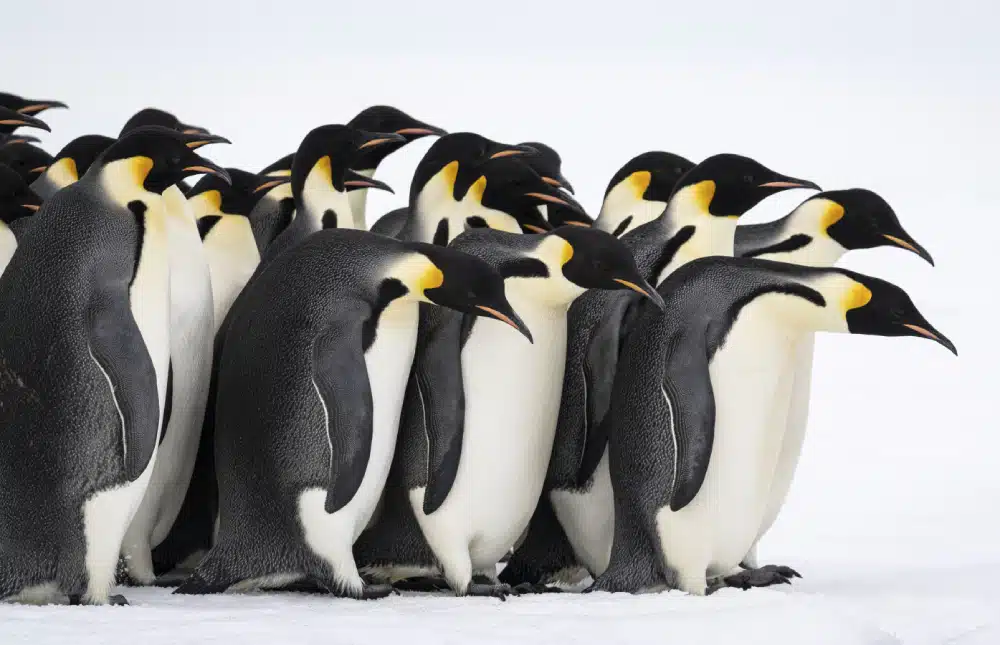Find out all there is to know about these seabirds, which thrive in extreme cold
From the biggest to the smallest, follow our guide to learn how to recognise these endearing and curious birds, the true sentinels of Antarctica. From the majestic emperor penguin to the mischievous southern rockhopper, Escales unveils their hidden talents.
The emperor penguin, the most emblematic
- Scientific name: Aptenodytes forsteri
- Average weight: 23 to 40 kg
- Average height: 100 to 130 cm (females are smaller than males)
- Location: Antarctic continent
- Food: fish, cephalopods and crustaceans
- Predators: killer whales and leopard seals for the adults; skuas and giant petrels for the chicks
- Plumage and distinguishing marks: black back and head, white belly, yellow spots around the ears, thin orange line on the beak
The emperor penguin is wonderfully well-adapted to the freezing conditions of Antarctica. What sets it apart is its ability to dive to depths of up to 500 metres and stay underwater for 30 minutes. As if that wasn’t enough, the emperor penguin is also the only penguin to breed on pack ice during the southern winter. The female lays a single egg then entrusts it to the male, who incubates it beneath his feet, protected under a fold of skin, until it hatches in mid-July. During this time, the female takes to the sea with the task of storing up enough food in her stomach to be able to regurgitate it and feed it to her chick upon her return.
The king penguin, the best diver
- Scientific name: Aptenodytes patagonicus
- Average weight: 8 to 16 kg
- Average height: 85 to 95 cm
- Location: subantarctic islands (Crozet Islands, Kerguelen Islands, Heard Island, McDonald Island, Macquarie Island, Prince Edward Islands, South Georgia Islands)
- Food: lanternfish (bioluminescent), crustaceans
- Predators: killer whales and sea lions for the adults; skuas and giant petrels for the chicks
- Plumage and distinguishing marks: black with orange tones on the sides of the head, graduated colours on the upper part of the breast and on the lower part of the long beak
The king penguin is the second largest species of penguin, after the emperor penguin. Although their elegant silhouettes may appear similar, they are in fact very different. Unlike the emperor who breeds on the pack ice of Antarctica, the king penguin prefers the mainland and beaches of the subantarctic islands for breeding, where it forms huge colonies.
Survival instinct: life in a colony
Penguins live in colonies for enhanced protection and to ensure their survival as best they can, particularly against predators, birds and marine mammals. The collective warmth generated by staying grouped together helps them to withstand the polar temperatures. Colonies are also true social constructs: living together makes it easier to find a mate and share responsibility for foraging and reproduction.
The gentoo penguin, the fastest under water
- Scientific name: Pygoscelis papua
- Average weight: 5 to 8 kg
- Average height: 50 to 95 cm
- Location: Antarctic peninsula, subantarctic islands (South Shetland Islands, Heard Island, McDonald Island, Macquarie Island, Kerguelen Islands, South Georgia Islands, Falkland Islands)
- Food: fish and crustaceans
- Predators: leopard seals, sea lions and killer whales for the adults; skuas and giant petrels for the chicks
- Plumage and distinguishing marks: white feathers on the belly and a white band from eye to eye forming a halo on the top of the head, bright orange beak, pink feet and a long tail
Gentoo penguins can lay claim to being the fastest swimmers in the penguin family, reaching speeds of up to 36 km/h under water! They mainly nest in areas that are sheltered from the snow, preferring beaches, valleys and small cliffs, where they are protected from flooding. When breeding, both gentoo parents incubate their two eggs for 37 days, having built a nest by piling up small stones, dry grass, feathers and other sufficiently resistant materials foraged from their environment.

Rémi Bigonneau, PONANT naturalist guide.
The Adélie penguin, the most mischievous
- Scientific name: Pygoscelis adeliae
- Average weight: 3.6 to 6 kg
- Average height: 70 to 75 cm
- Location: Antarctic continent, South Shetland Islands, South Orkney Islands
- Food: crustaceans, krill, fish
- Predators: leopard seals for the adults; skuas and giant petrels for the chicks
- Plumage and distinctive signs: white ring around the eyes, black feathers down to the tip of the beak to protect against extreme cold
In 1837, French explorer Dumont d’Urville was the first to record a sighting of a new species of penguin, which he named Adélie after his wife Adèle. To nest, Adélie penguins gather on rocky ground close to the sea, building their nests by piling up pebbles found nearby or by stealing those from neighbouring nests. Both parents incubate their two eggs together for 35 to 37 days, and raise their chicks until they are two months old.

Rémi Bigonneau, PONANT naturalist guide.
The chinstrap penguin, the champion sleeper
- Scientific name: Pygoscelis antarcticus
- Average weight: 3.4 to 5 kg
- Average height: 68 to 76 cm
- Location: subantarctic islands (South Shetland Islands, South Orkney Islands, Bouvet Island, South Sandwich Islands)
- Food: Antarctic krill
- Predators: leopard seals for the adults; skuas and giant petrels for the chicks
- Plumage and distinguishing marks: a fine black stripe that goes around the throat, and a short black beak that contrasts with its white ventral area
When you reach territories shared by Adélie penguins and gentoo penguins, be sure to keep your eyes open for huge colonies of chinstrap penguins, which are often not far away. Their ‘chinstrap’ name comes from the thin black stripe that goes around their throat. They lay two eggs precisely three days apart between October and February. Like Adélie penguins, they are incubated by both parents for 37 days.
10,000 naps a day
Did you know? In 2023, CNRS researcher Paul-Antoine Libourel shared some astonishing data collected in Antarctica: chinstrap penguins nap for an average of 4 seconds, up to 10,000 times a day! This is how it manages to get its daily dose of 11 hours’ sleep!
The macaroni penguin, the most original
- Scientific name: Eudyptes chrysolophus
- Average weight: 2.4 to 3.6 kg
- Average height: 70 cm
- Location: subantarctic islands (Crozet Islands, Kerguelen Islands, Heard Island, McDonald Island, Macquarie Island, Prince Edward Islands, South Georgia Islands and South Sandwich Islands)
- Food: krill, small fish and cephalopods
- Predators: sea lions and sea leopards for the adults; giant petrels and skuas for the chicks
- Plumage and distinguishing marks: long bright yellow feathers that curl around the eyes and meet at the forehead, a broad orange beak, red eyes
The macaroni penguin was given its name by British sailors in the early 19th century, as its yellow crest evoked the outfits of the fashionable ‘macaroni’ men – a bit like today’s hipsters – from the 18th century. This sociable bird spends much of its life at sea and nests on rocky coasts and cliffs. Two eggs are laid by the female and incubated by both parents for between 33 and 37 days, with only one egg eventually hatching.
The southern rockhopper penguin, the most daring
- Scientific name: Eudyptes chrysocome
- Average weight: 2.3 to 4.2 kg
- Average height: 40 to 58 cm
- Location: subantarctic islands (Falklands Islands, Crozet Islands, Kerguelen Islands, Heard Island, Macquarie Island, Prince Edward Islands)
- Food: krill, squid and small fish
- Predators: leopard seals and sea lions for the adults; skuas and giant petrels for the chicks
- Plumage and distinguishing marks: bright yellow crest that rises from the top of the beak and spreads to the back of the head; crest is thinner and less bushy than that of the macaroni penguin
The southern rockhopper penguin certainly lives up to its name. It has the astounding ability to climb to the top of cliffs, ascending with a succession of small, graceful hops. The colonies, which can be made up of hundreds of thousands of individuals, are established on rocky land near the shore, where they nest. Although two eggs are incubated by both parents for 32 to 34 days, it is rare for the smaller of the two to survive.
Discovering penguin colonies beyond Antarctica
While Antarctica and the subantarctic islands are prime penguin spotting territory, some species can be viewed elsewhere in the southern hemisphere. The coastline of New Zealand’s South Island, the Chatham Islands, Stewart Island, the southern coast of Australia and Tasmania are all natural habitats of the little blue penguin, the smallest of these seabirds. The African or Cape penguin, meanwhile, can be found along the coasts of South Africa and Namibia, while the Magellanic penguin can be observed along the coast of the Falkland Islands and on the southern coasts of Argentina and Chile.
Penguins and auks: how to avoid confusing the two
Although we tend to confuse them, auks and penguins are quite different and are found in diametrically opposed areas of the planet. Auks live in the northern hemisphere and are flying birds, unlike penguins, who are native to the southern hemisphere and whose wings are more like fins, making them extremely dynamic and agile in the water.
Photos credits: ©StudioPONANT: M. Monneret; M. Lanco; O. Bleunven; J. Marchi; O. Blaud; N. Michel; A. Morlent;
©PONANT Photo Ambassador-Sue Flood

Head for the White Continent.



